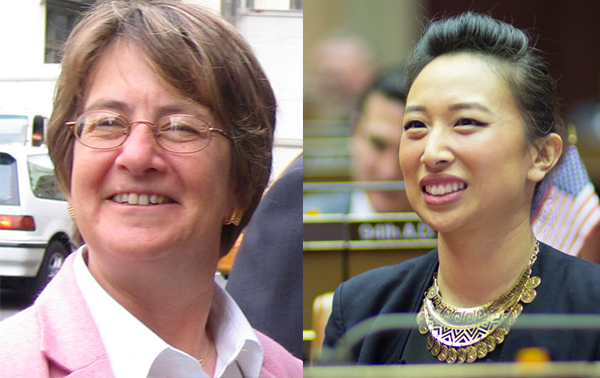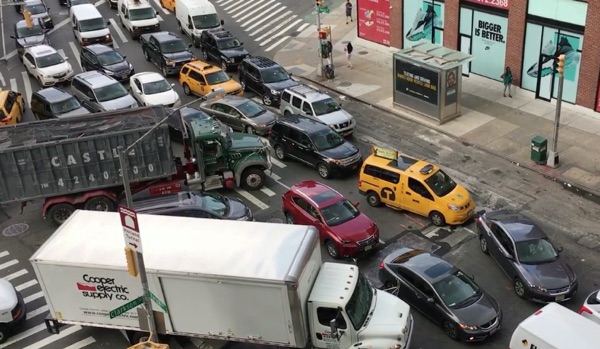The New York Times has a feature today about pedestrian crossing guards on Varick Street near the Holland Tunnel — “pedestrian bodyguards,” The Times calls them.
The guards shine as resourceful, unassuming heroes whose brave physical interventions keep encroaching drivers at bay. But hidden in the story is a deeper message, about motor traffic's human toll that our politicians decry only with words, not deeds.
The story, "Crossing Guards for Grown-Ups? Yes, Traffic Is That Bad," by Winnie Hu, lets the folks charged with massaging Varick gridlock do the talking. And they explain better than any engineer or spreadsheet just how insane traffic is and how it taxes us physically and psychically.
"The traffic is overwhelming," says Doris Garcia, 44, a mother of four from Brooklyn who supervises the pedestrian safety managers. "Pedestrians yell at drivers. If drivers don’t listen, sometimes we have to put our whole body in the intersection just to stop the cars."
The story also reveals, though inadvertently, the disconnected vision of every downtown elected official and other “influencer” who isn’t gearing up to get Albany to enact the most robust version of congestion pricing possible when the legislature convenes next week.
What’s the disconnect? It’s when downtown officials pose as champions of taming traffic in Manhattan south of 14th Street while disdaining congestion pricing. It’s when downtown residents blame downtown gridlock on the one-way Verrazano Bridge toll, but turn a blind eye to the absence of tolls on the East River bridges that incentivizes even more drivers to pour into and through lower Manhattan.
Since 1986, when Congress voided MTA control over Verrazano tolls, thousands of motorists bound from Long Island to New Jersey every day have been detouring through lower Manhattan in order to avoid the double westbound Verrazano toll.
But here’s the thing: Congestion pricing will cut that traffic — the very traffic that the Varick Street crossing guards toil valiantly to control — more than any other proposed policy measure. And unlike the competition, congestion pricing is winnable, now.
In a study last spring for the Hudson Square BID, Sam Schwartz Engineering concluded that the Fix NYC congestion pricing plan would remove 33 percent more traffic from Canal Street than restoring two-way tolling to the Verrazano Bridge. The Move NY version of congestion pricing would outperform two-way tolling by a whopping 80 percent. (Disclosure: I was part of the Sam Schwartz Engineering analysis team for the study.)
For three decades, in downtown’s longest-running kabuki theater, local officials have ritually denounced the Verrazano one-way double toll and demanded it be repealed. Now, with the even more effective antidote of congestion pricing within reach, are these officials elbowing each other out of the way to champion it? Hardly.

When last heard on the issue, last January, Assembly Member Yuh-Line Niou, whose 65th Assembly District includes the traffic-battered Lower East Side and Chinatown, was insisting on a resident exemption — a massive and undeserved carve-out that would detonate a cascade of special pleading across the city and doom congestion pricing.
Assembly Member Deborah Glick (Greenwich Village including Hudson Square), a diehard opponent of congestion pricing since the Bloomberg era, may be signaling a change of heart. In “Thoughts on Congestion Pricing,” a textbox in her most recent constituent newsletter (Neighborhood Update 63, not yet on line), she touches all the bases, calling mass transit “the circulatory system of our city,” acknowledging transit’s “desperate need of major and ongoing funding,” and decrying “the unhealthy congestion in our streets.”
That reads like the start of a major pivot. Glick now needs to finish her 180, championing congestion pricing and bringing Niou and other legislative fence-sitters into the fold.






